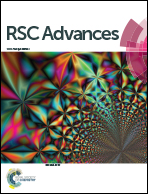Novel ammonium dichloroacetates with enhanced herbicidal activity for weed control†
Abstract
Dichloroacetic acid (DCA) exhibits great potential as an herbicide (nontoxic, easily biodegradable), but its application in agriculture has scarcely been investigated. Since DCA readily undergoes photolysis when exposed to natural light or UV irradiation, there is a large activity loss in controlling weeds. To improve the activity of DCA, we proposed the transformation of DCA into an ionic salt form by using an herbicidal ionic liquids (HILs) strategy. Herein, fifteen novel ammonium dichloroacetates were designed and achieved for the first time. When compared to the anionic precursor DCA, three salts with longer alkyl chains ranging from dodecyl to hexadecyl chains were found to enhance not only the post emergence herbicidal activity but also the rates of activity against some broadleaf weeds under greenhouse conditions. The enhancement was due to the synergistic effect of structural factors, such as the surface activity, solubility and stability arising from their ionic nature. In addition, IL 13 possesses a low phytotoxicity to cotton plants with a favorable selectivity index above 2. This study will be useful for the design of new, high-performance herbicidal formulations.



 Please wait while we load your content...
Please wait while we load your content...